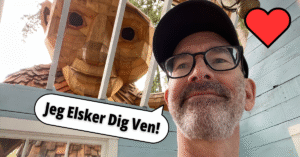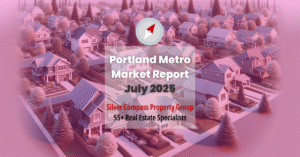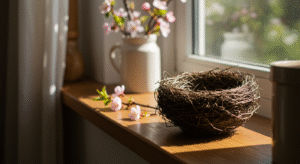
A Troll and an Innovative Danish Idea
Last month, I invited a friend to coffee at Nordic Northwest, eager to introduce her to Ole Bolle, the magical wooden troll created by Danish artist Thomas Dambo that has become such a beloved Portland attraction. Between finishing our coffee at Broder Söder and wandering outside to admire Ole, I stumbled on something unexpected in the Nordic Northwest gallery: the traveling Boliglaboratorium (Housing Lab) exhibit from Denmark.
The coincidence felt important. Here I was, just looking for a bit of whimsy and good coffee, but this chance encounter sparked something in me. The exhibit showcased co-housing communities—intentional neighborhoods where private homes are thoughtfully arranged around shared spaces, fostering natural connections between neighbors.
It was an “ah-ha” moment that I immediately connected to my growing awareness of what public health expert Kasley Killam calls “social health”—the often-overlooked third pillar of wellness alongside physical and mental health. And, of course, I also connected it to my own clients and their wishes for a thriving home environment as they age.
Living the Social Health Experience
My enthusiasm for co-housing isn’t purely theoretical. I live in what I call an intergenerational family compound, where three generations—ranging from age 83 to just 4 years old—share adjacent homes arranged around a lovely patio. We naturally gravitate toward communal activities: sharing meals on the patio, working together in our vegetable garden, gathering around the fire pit for evening conversations, and letting the kids splash in the kiddie pool while adults catch up on the day. There’s even a bouncy-house that gets inflated for special occasions!
This living arrangement has shown me firsthand how intentional community design can combat the isolation that too often comes with modern life and is particularly insidious as we grow older. In “The Compound”, our physical proximity and supportive relationships make our daily interactions effortless and meaningful. It’s not just about convenience—it’s about the repeated reinforcement of real connection and purpose that comes from being truly known and cared about by the people around you.
This experience opened my eyes to why multi-generational living arrangements are gaining popularity, and it made me deeply curious about how other intentional communities like co-housing might address the social health needs of aging adults.
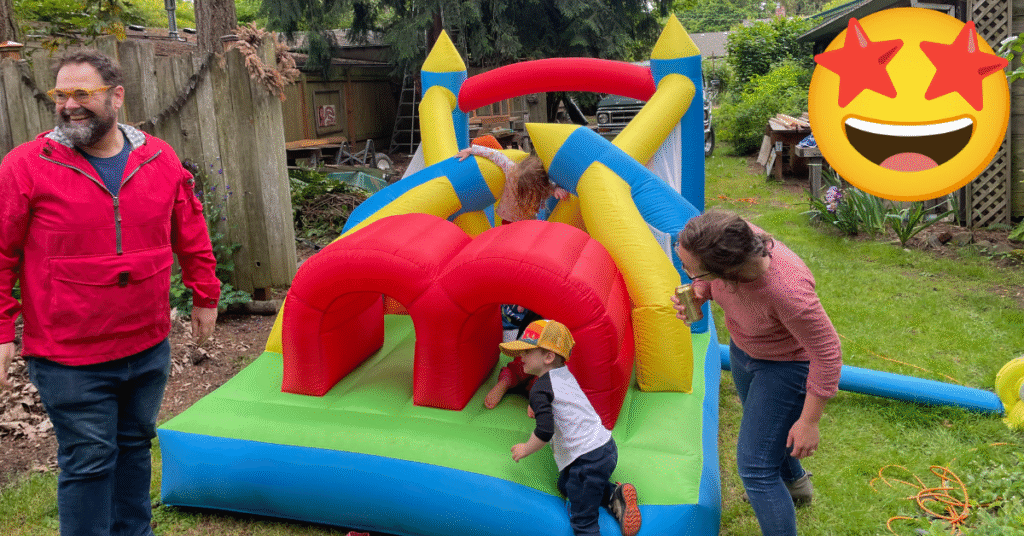
The Missing Key: Social Health in Aging
In her inspirational book The Art and Science of Connection, Killam argues that social health is “the missing key to living longer, healthier, and happier.” The research is compelling: strong social connections can reduce the risk of premature death by 50%, while persistent loneliness carries health risks equivalent to smoking 15 cigarettes a day.
For older adults, the stakes are particularly high. The natural transitions of aging—retirement, empty nesting, loss of peers, mobility changes—can gradually erode the social networks that we once relied on, even if unconsciously. The Guardian, in a recent article on the benefits of co-housing, reports that many seniors find themselves increasingly isolated, despite their best intentions to maintain connections.
Yet social health isn’t just about avoiding loneliness. It encompasses the sense of purpose that comes from contributing to something larger than ourselves, the cognitive stimulation of diverse conversations, and the emotional security of knowing we’re surrounded by people who care about our well-being. These elements don’t happen by accident—they require intentional cultivation.
This is where co-housing communities shine, creating structural opportunities for the kind of natural, ongoing social connections that support healthy aging.
Co-housing: Supportive Community by Design
Co-housing originated in Denmark in the 1960s and represents a fundamentally different approach to neighborhood living. Unlike traditional housing where good neighbors are a “lucky coincidence,” co-housing communities are deliberately designed to foster connection and mutual support.
The model is beautifully simple: private homes or condo units are clustered around shared common areas—kitchens, dining rooms, gardens, workshops, and gathering spaces. Residents own their individual units but collectively own and manage the shared facilities. Most communities organize regular shared meals, collaborative decision-making sessions, and work days where neighbors help maintain their common spaces.
What makes co-housing particularly relevant for aging adults is its emphasis on independence within a community. As Cascadia Daily News notes, these aren’t care facilities, but rather supportive communities where neighbors naturally look out for one another. When someone travels, others keep an eye on their place. When someone needs a ride to an appointment, neighbors often step in. When life throws challenges, there’s an established network of people who care.
This model stands in contrast to traditional senior communities, which often excel at providing services and amenities but may not emphasize the deep community connections that co-housing prioritizes. Both approaches have merit; co-housing simply offers a different path for those who place particular value on collaborative living and shared decision-making.
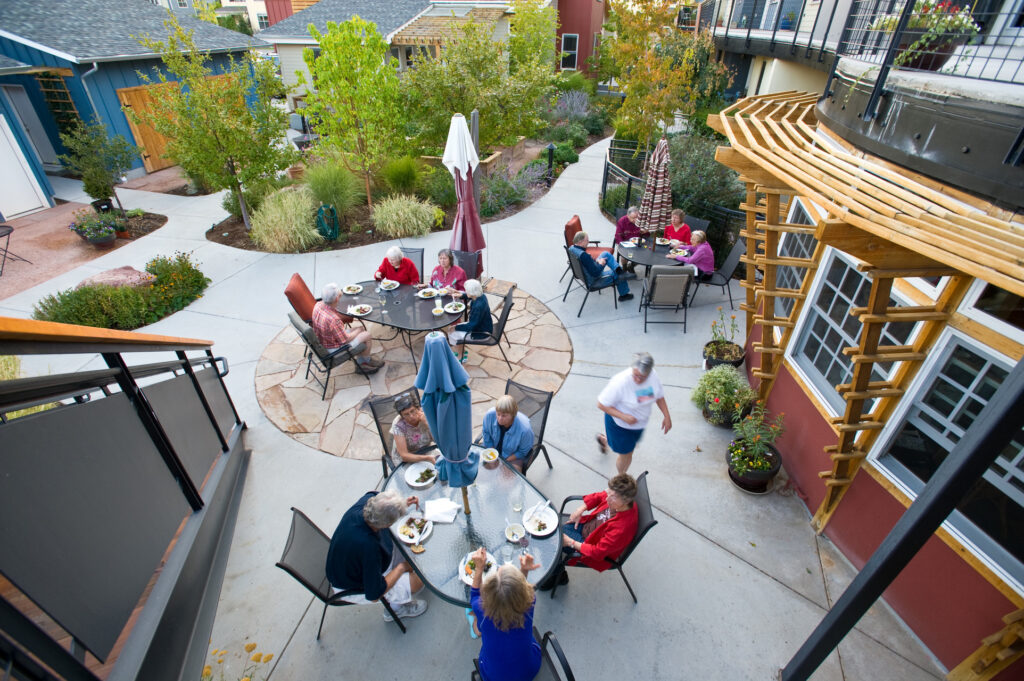
Portland Senior Co-housing Communities: Local Pioneers
Portland has emerged as a co-housing haven, with, depending on exactly how you define co-housing, 8-12 communities throughout the metro area. Two local examples illustrate how this model translates into daily life and social health benefits for those exploring Portland senior co-housing options.
PDX Commons: Urban Aging Together
PDX Commons represents the gold standard for Portland senior co-housing. This 55+ community of 35 adults, housed in a thoughtfully designed four-story building on SE Belmont, embodies what they describe as “exploring aging together in a vibrant urban space, with respect, compassion, laughter, and friendship.”
What sets PDX Commons apart is their explicit commitment to community as a core value, not an afterthought. Residents share ownership of extensive common areas—a commercial-style kitchen, dining room, library, media room, craft and exercise spaces, roof deck, and gardens. They organize regular community meals, make decisions through consensus, and actively support each other’s wellbeing.
The community’s FAQ reveals their intentionality: “For us, a strong community is an explicit goal, not a lucky coincidence.” This philosophy creates an environment where social health naturally flourishes. When residents travel, neighbors look after pets and water plants. When someone needs encouragement or celebration, the community rallies. When decisions need to be made about their shared life, everyone has a voice.
Located with easy access to public transit, parks, and SE Portland amenities, PDX Commons demonstrates how co-housing can enhance rather than limit the lifestyle choices that matter to active older adults.
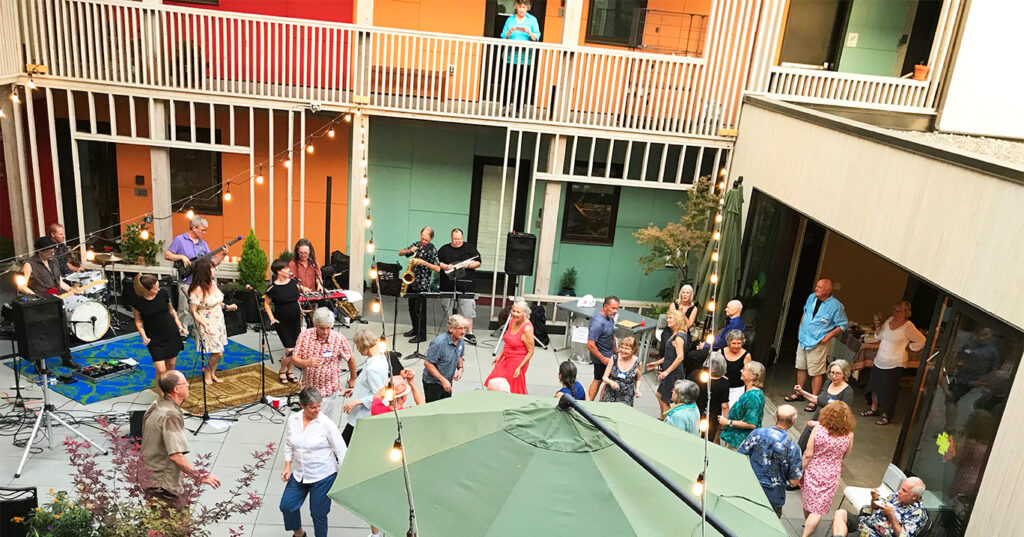
Daybreak Co-housing: Intergenerational Magic
Daybreak Co-housing in North Portland takes a different but equally worthwhile approach. This intergenerational community of 30 households houses 45 residents, from young families to retirees, creating natural opportunities for the kind of intentional connections that research shows benefit all age groups.
Daybreak’s rhythm of life centers around shared meals, community work days, and collaborative decision-making. Residents participate in two community dinners weekly, join working teams that maintain their shared spaces, and attend monthly business meetings where they make decisions together about their community life.
The intergenerational aspect offers unique social health benefits for older residents. Children bring energy and perspective, younger adults offer different skills and viewpoints, while older residents contribute wisdom and often more flexible schedules for community involvement. It’s a natural ecosystem where everyone both gives and receives.
Both communities require significant participation from residents—attending meetings, contributing to meals, joining work teams—but this involvement is precisely what creates the social health benefits that make co-housing so compelling for aging adults.
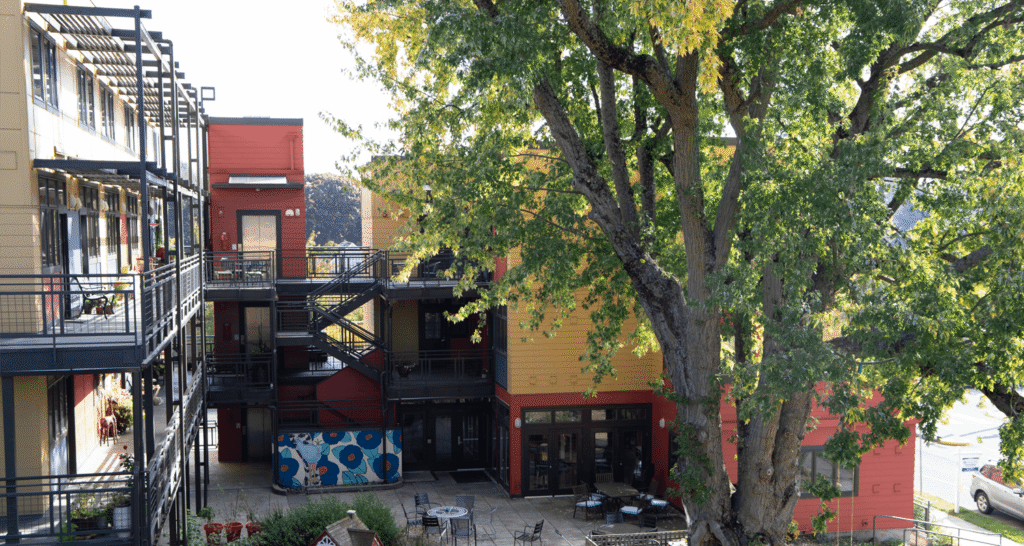
Is Portland Senior Co-housing Right for Your Future?
Co-housing isn’t for everyone, and that’s perfectly fine. The model requires comfort with collaborative decision-making, willingness to participate actively and consistently in community life, and a genuine desire for more intimate neighborhood relationships.
Consider whether co-housing aligns with your values by reflecting on these questions:
- Do you thrive in collaborative environments, or do you prefer making independent decisions?
- Are you energized by regular social interaction, or do you value extensive privacy?
- Do you enjoy contributing to group projects and shared responsibilities?
- Are you comfortable with the give-and-take of community consensus?
- Do you see your neighbors as potential friends, or do you prefer more distant relationships?
According to a recent article from Oregon ArtsWatch, co-housing particularly appeals to people seeking an alternative to both isolation and institutional care—those who want to age independently while remaining deeply connected to community.
The beauty of exploring Portland senior co-housing options lies not in finding the “perfect” solution, but in intentionally considering how you want to structure your social health as you age. Whether that leads to co-housing, traditional retirement communities, aging in place with strong neighbor connections, or innovative arrangements like multi-generational compounds, the key is making conscious choices about the social environment that will support your long-term well-being.
Charting Your Path Forward
My encounter with that Danish “Housing Lab” exhibit reminded me that some of life’s most important discoveries happen when we’re open to unexpected connections. My dear friend Ole Bolle led me to an exhibit about innovative housing, which deepened my understanding of social health, which reinforced my appreciation for the intentional community I’m already part of.
Whether Portland senior co-housing communities capture your imagination or simply open your thinking about aging alternatives, the important thing is approaching these decisions thoughtfully. At Silver Compass Property Group, we believe in helping clients explore all the options that might support their vision of successful aging—from co-housing communities to traditional neighborhoods, from downtown condos to suburban homes with space for extended family.
The goal isn’t to find the single “right” answer, but to make informed choices that align with your values, lifestyle preferences, and both physical and social health needs. Because, as Kasley Killam reminds us, our connections to others aren’t a luxury—they’re essential to living longer, healthier, and happier lives.
Ready to explore what housing options might best support your social health as you age? Let’s start that conversation.
Resources for Further Exploration:
- Danish Housing Lab
- PDX Commons Senior Cohousing
- Daybreak Cohousing
- The Cohousing Association of the United States
- The Art and Science of Connection by Kasley Killam
Thanks for reading : )
Peter Lindberg
Lead Broker – Silver Compass Property Group
Senior Real Estate Specialist (SRES)
503-806-4277




